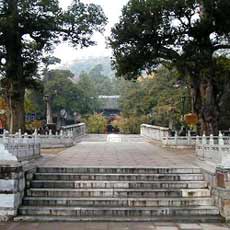
Nestled in the hills northwest of Beijing is the Dajue Temple, a quiet thousand-year-old retreat far from the city's tourist sites.
Covered by ancient trees, the temple grounds are a great place to cool off during Beijing's hot summer. It is also quite popular in early April when the yulan magnolia flowers are in full bloom, which the temple celebrates with a festival. A yulan magnolia planted by a monk almost 300 years ago is the main attraction.
The present ripening season is also a good time to visit, when the bright yellow leaves of a thousand-year-old gingko form an irresistible backdrop for a traditional Chinese tea ceremony within the temple.
The gingko tree was alive when the original temple was built in 1068 during the Liao Dynasty (916-1125). More than a thousand years old, it is supposedly the oldest in Beijing. The tree still looks healthy and at present has a massive golden umbrella unrivalled by any other gingko tree in Beijing.
Yet the gingko is far from the only attraction at the temple, which is also home to numerous ancient trees, a spring, a teahouse and a large number of cultural relics.
Located at the foot of Mount Yangtai, northwest of Haidian District, the temple is quiet and tastefully laid out, with a stretch of level, fertile land in the front and densely wooded peaks at the back. A crystal-clear stream flows through the temple the year round, where the courtyards are decorated with sky-tall trees of every shape.
There is a small museum inside the temple, dedicated to its history and main attractions.
Within is a Liao Dynasty stela, on which it is recorded that, more than 1,000 years ago, the temple was named the "Clear Stream Court" after the nearby springs. Although the carving is blurred and the stela itself is broken into two pieces, most of the inscription remains legible. Scenic photos taken during different seasons are also on display.
A random stroll within the temple itself is quite pleasant, whether contemplating its long history, enjoying its scenic beauty or just resting on the banister of the temple's front pool watching multi-colored fishes frolic while turtles dive and rest.
However the best part of the visit is to ask for a tea service at the Minghui Teahouse within the temple. It could be one of the nicest teahouses in China, and perhaps the most pleasant. Musicians dressed in traditional garb play the gentle music of 25-stringed zithers while patrons sip tea and eat snacks in the shade. Children can often be seen playing but surprisingly, not bothering anyone at all, probably because of the tinkling sound of stream and the caressing breeze.
The staff can conduct a 21-step formal tea ceremony that precedes your first taste of the tea. They actually went to school to learn tea culture.
The teahouse also has beautiful traditionally furnished guesthouses that look like they would make for a nice stay. Nearby in the temple is a restaurant serving Shaoxing food from east China's Zhejiang Province. But bringing your own for a picnic is recommended.
It is not the first site one should see in Beijing, but it is certainly worth a visit during an extended stay.
However, since the temple is some 50 kilometers northwest of Beijing, and it takes upwards of an hour to get there from downtown, it is best to have a driver who knows the way.
If you want to see more, there are a number of interesting sights in the immediate vicinity. They include Vulture Peak (Jiu Feng), the tomb of a Qing prince, the Yang Family Garden and Lotus Temple and the Temple of Universal Grace. All are accessible by mountain roads.
How to get there: Take the Badaling Highway to the north and get off at the Beianhe Exit. Then take Beiqing Road to a T-junction, and turn right for the temple. Check signposts along the way.
For visitors starting from west of downtown Beijing, go north beyond the Summer Palace, pass through Heishanhu, Xibeiwang, Heilongtan (Black Dragon Pool) and the Wenquan (Hot Springs), and then go through the two villages of Beianhe and Zhoujiaxiang before coming to a steep path, which leads to the main gate of the Dajue Temple.
Bus route 346 from the Summer Palace gets you to Beianhe Nankou Stop, which is two kilometers away from the temple.
Cost: A standard entry ticket goes for 20 yuan (US$2.46); if you want to have tea in the Minghui Teahouse, tell them at the ticket office and you are given a card, which ensures you get 10 yuan (US$1.23) back upon your tea purchase. The tea itself is expensive, partly because of its high quality. You are supposed to buy a small can of tea, the cheapest at 100 yuan (US$12.34), which you can share among four friends.
Tel: 86-10-62456163 (Chinese only).
(China Daily October 14, 2005)
|

